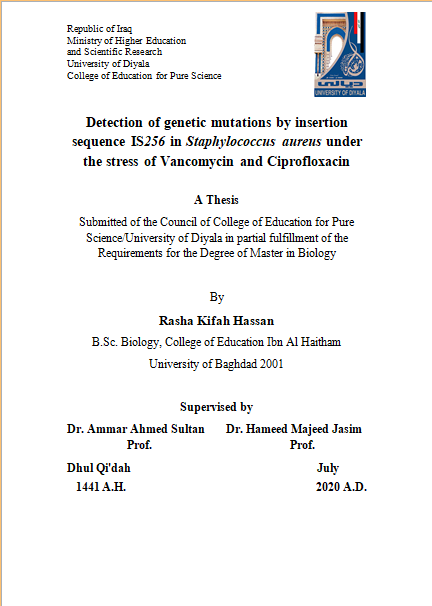Summary
A total of 109 clinical specimens were collected from burns, nose, urine, joint fluid, vagina, blood, sputum and tip drainage and soft tissues from surgical operations for patients attends Baghdad teaching hospital and the division of laboratories/ private nursing hospital in Baghdad Governorate for the period from July/2019 to September/2019. From these samples a total of 109 bacterial isolates were obtained after culturing on McConkey agar and Blood agar plates. After screening these bacterial isolates, it was found 47 of them were Gram positive and 62 Gram negative bacteria. Twenty-two of G+ve bacteria were identified as Staphylococcus aureus according to their ability to cause β-heamolysis, monnitol fermentation, they were positive for catalase, lisithinase, urease, while they were negative for oxidase. Identification of these isolates was confirmed by using Viteck-2.
Susceptibility of S.aureus isolates to different antibiotics was determined. Results showed these isolates have different resistant profile for different antibiotics, where all the isolates (100%) were resistant to penicillin and methicillin, 77% were resistant to ampicillin, 53% were resistant to erythromycin, 45% to azithromycin, trimethoprim and chloramphenicol, 36% were resistant to tetracycline, 23% to ciprofloxacin, doxycillin and lincomycin, 18% to refampin and 4% for vancomycin.
Genomic DNA was extracted from all S.aureus isolates with high purity and concentration, then insertion sequence 256 (IS256) was detected by using specific primers. Results showed that IS256 was detected in 18 isolates, and the prevalence of this transposable element in bacterial isolates from clinical samples was 100% in UTI isolates, nose, wounds, tip drainage and soft tissues isolates, 66% in respiratory isolates, 33% in joint fluid isolates, and this element was not founded in vagina and blood isolates.
S.aureus S1 was selected from the other bacterial isolates because it was multidrug resistant and the most antibiotic resistant isolate to study the stress of vancomycin and/or ciprofloxacin on transposition frequency by IS256 and inactivate antibiotic resistance genes by pretreatment of this isolate with the subinhibitory concentration of vancomycin and / or ciprofloxacin for six hours intervals, then aliquots were taken each hour and spread on Brain- Heart infusion agar containing the antibiotic that the bacterial isolate was resist and calculation the transposition frequency and survival fraction (%). Results showed that the pretreatment with vancomycin was more effective than ciprofloxacin and both vancomycin and ciprofloxacin according to higher transposition frequency and inactivating antibiotic resistance genes, and decrease the survival fraction after this pretreatment.





